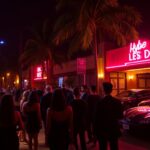In the early 2000s, the nightlife of Los Angeles was not merely a form of entertainment; it was a cultural phenomenon. The pre-streaming era was marked by an electric atmosphere of secrecy and indulgence, where the rich and famous would gather in exclusive venues, creating a world away from the prying eyes of social media. This was a time when the art of enjoying life was celebrated through elaborate parties, clandestine meetings, and unforgettable moments.
Clubs like Hyde, Teddy’s at the Roosevelt Hotel, and Les Deux became synonymous with celebrity culture, where stars and starlets rubbed shoulders with their publicists, stylists, and other industry insiders. The energy was palpable, and the allure of these venues was immortalized in reality shows like The Hills and the pages of gossip magazines that chronicled every glamorous escapade.
The allure of exclusive venues
Some of the most talked-about events took place in dimly lit rooms where the drinks were strong and the cameras were few. Prominent figures of that era, such as Paris Hilton, Britney Spears, and Lindsay Lohan, dominated the tabloids, often with their antics making headlines. The paparazzi had limited access, and the worst consequence of a wild night typically involved a mention in Page Six days later. This sense of freedom allowed for uninhibited behavior that has become a distant memory in today’s image-obsessed world.
Inside the nightlife scene
Brent Bolthouse, a key player in the nightlife scene, recalls moments filled with excitement and spontaneity. With a keen eye for creating a community, he recounts how celebrities would gather without fear of judgment or exposure. “Thank God there were no cameras,” he reflects on nights filled with laughter and revelry. The only concern was a potential flip phone photo, which might make its way to Us Weekly four days later.
As the head of Bolthouse Productions, he was instrumental in transforming venues like the Viper Room and House of Blues into hotspots for A-listers. “We created an environment where people felt safe to be themselves,” he emphasizes. This sense of belonging was crucial to the allure of these exclusive parties, where everyone felt like they were part of something special.
The rise of bottle service
Another significant element that characterized this vibrant nightlife was bottle service. Bolthouse introduced this trend to Los Angeles, bringing a taste of European nightlife to the city. As Lisa Love, former West Coast director of Vogue and Teen Vogue, notes, this innovation attracted a wealthier crowd, eager to experience the exclusivity that came with a dedicated table and personal service.
As a result, the dynamics within these clubs shifted. People began to flaunt their wealth and status openly, creating a competitive atmosphere where being seen at the right table was paramount. “If you got into Hyde, you were in,” recalls publicist Jessica Meisels, emphasizing the importance of reputation in this high-stakes environment.
Memorable nights and unexpected performances
The unpredictability of these nightlife events added to their charm. It was not uncommon for spontaneous performances to break out, with artists like Prince showing up unannounced and playing private shows until the early hours of the morning. The thrill of such surprises kept the energy alive and fueled the desire to be part of this exclusive scene.
As Amanda Demme, photographer and creative director, recalls, “Having Prince perform was a once-in-a-lifetime experience.” These magical moments were not documented on social media; they existed solely in the memories of those fortunate enough to be present. It was a time when going out meant participation in a shared experience, rather than curating a public image.
The darker side of celebrity culture
While the glamour of this nightlife scene was captivating, it also came with its share of challenges, particularly for young women. The tabloids often scrutinized their every move, creating an environment of pressure and judgment. Publicist Elliot Mintz notes, “Most of the individuals targeted by the media during this era were women,” highlighting the disproportionate focus on female celebrities and their struggles.
Despite the thrilling escapades and iconic moments, the culture of the aughts was unforgiving. It often blurred the lines between personal lives and public personas, leaving many to navigate the complexities of fame under the watchful eye of the press. “It was a time where you had to be careful,” Mintz adds, reflecting on the impact of public perception on these young stars.
In retrospect, the nightlife of early 2000s Los Angeles was a vibrant tapestry of celebrity culture, creativity, and glamour. It fostered an environment where connections were made, memories were created, and the essence of living in the moment was celebrated—an era that, although fleeting, continues to evoke nostalgia for those who experienced it.




